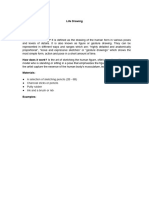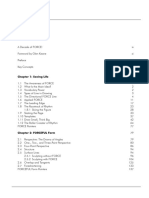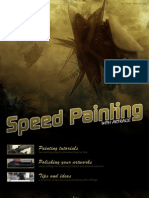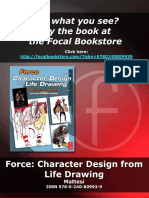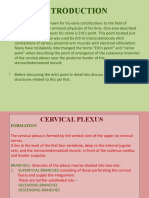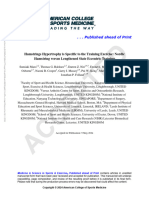Ron Lemen - Perspective and Elevation in Figures - Muddy Colors
Ron Lemen - Perspective and Elevation in Figures - Muddy Colors
Uploaded by
screwyourregCopyright:
Available Formats
Ron Lemen - Perspective and Elevation in Figures - Muddy Colors
Ron Lemen - Perspective and Elevation in Figures - Muddy Colors
Uploaded by
screwyourregOriginal Title
Copyright
Available Formats
Share this document
Did you find this document useful?
Is this content inappropriate?
Copyright:
Available Formats
Ron Lemen - Perspective and Elevation in Figures - Muddy Colors
Ron Lemen - Perspective and Elevation in Figures - Muddy Colors
Uploaded by
screwyourregCopyright:
Available Formats
Perspective and Elevation in the Figures You Draw about:reader?url=http://www.muddycolors.com/2015/09/perspective-and...
muddycolors.com
Ron Lemen
-By Ron Lemen
Hello all and happy September. We are in Montana at the moment, taking in
some breathtaking scenery while visiting my family. I will finish the second part to the False
Start article I began a few weeks back when I return to San Diego. While we have been out of
town I have been
pondering many additional topics I am adding to my figure drawing book and I
would like to share one of them with you here.
I draw from the figure almost daily. I teach several classes during the week that
allows me to stay close to the subject and the rest of my work time is spent
doing illustrations, character designs and commissions where I am constantly
working with and manipulating characters.
I am constantly reminded of the problems we face when drawing, and
especially when working with the figure.
The most universal problem I have found with many artists,
beginners, and intermediates as well as with many seasoned professionals is matching
everything drawn in a scene to the horizon line, especially organic shapes and
of course the figure. Many times the
figure is drawn with a flat forward look to every part of the body. In other words, there is no
real elevation
change in the figure from head to toe and/or if there is, it is only emphasized
where it is most obviously recognizable.
1 of 8 Mon, 31/12/2018 03:11
Perspective and Elevation in the Figures You Draw about:reader?url=http://www.muddycolors.com/2015/09/perspective-and...
There are tools that the artist can use to solve this issue
long before investing time in the rendering.
If we use landmarks, ellipses and overlap shapes using a strong draw
through method, as well as indicate a ground plane and possibly a horizon line,
unless we fall asleep at the drawing wheel theses tools should work well
setting up solid armatures to take to a finish.
Landmarks, also known as subcutaneous boney surfaces, are
the bones under the skin that influence the surface. The skull for the most part is one large
subcutaneous landmark. With exception to
the cheeks, most of the skull is just below the skin. The clavicles, the sternum, the elbows, the
knees, etc. are landmarks we look for. One
use of the landmarks is to compare the left side of the body to the right side
of the body. Using the centerline as a
gauge for these landmarks, we align the left side with the right side or the
front with the back based upon the landmarks, their elevation and their
distance to one another. The following
skeletons show the landmarks of both the front and the back of the skeleton.
2 of 8 Mon, 31/12/2018 03:11
Perspective and Elevation in the Figures You Draw about:reader?url=http://www.muddycolors.com/2015/09/perspective-and...
The mannequin is the starting point for the figure, or the
armature that represents the skeletal structure of the pose. The core of the skeleton is called
the axial
skeleton while the arms and legs are called the appendicular skeleton. Ellipses should be
drawn around the axial
skeleton near the neck, the 10th ribs, the pair of iliac crests and
the base of the pelvis including the greater trochanters. The upper and lower half of each leg
and arm
should have ellipses drawn around them dividing each segment of each
appendicular limb into thirds. This
division will come in handy when drawing out the proportions of the muscles and
tendons.
These ellipses drawn help us understand a few things we are
looking at. The first is the
foreshortening of a space. The more
circular you see the elliptical lines the more you are looking straight through
the object. The flatter the ellipses,
nearing a straight line, the more perpendicular we are facing that
ellipse. The other use of the ellipses
is when we draw these ellipses around the cylinder forms we are placing markers
on the body to help us with volume as well as with elevation. If we sit low to the model then
we should be
looking up under the ellipses more and if we are above the model we should be
looking down at the ellipses. This
diagram below further illustrates this concept.
3 of 8 Mon, 31/12/2018 03:11
Perspective and Elevation in the Figures You Draw about:reader?url=http://www.muddycolors.com/2015/09/perspective-and...
Overlapping lines and shapes also help with identifying the
spatial relationships with the body.
Overlapping shapes can and usually indicate foreshortened sections of
the body. The shapes should be drawn
using the draw through method. With the
draw through method shapes are completed, spaces are totally resolved and more
information than is necessary is found helping the artist fully realize where
all the parts of the body are with any pose.
Overlapping lines are very similar and are used in places like the hips
or any bending segment of the body. Of
the converging lines, one ends abruptly called a broken line and the other
becomes the tangent. The tangential line
indicates one volume passing behind another volume indicated with the broken
line.
4 of 8 Mon, 31/12/2018 03:11
Perspective and Elevation in the Figures You Draw about:reader?url=http://www.muddycolors.com/2015/09/perspective-and...
Now, when starting the figure drawing elevation is critical
to the delivery of convincing forms in 3D space. When drawing from a photograph it might be
more difficult to indicate where the eye level is. Hint: If
the reference is a full figure from head to toe then look at the feet. The rise of the heels in
relationship to the
toes and the reverse is very telling of the perspective of the pose. If the photo is cropped then
it will be more
difficult to observe where the proper eye level is to the horizon line. When life drawing or
shooting photo reference
for an illustration we have to be fully aware of our position to the model.
Drawing in a ground plane is always helpful and beneficial
to reminding the artist that the figure drawn exists in 3D space. Gridding the floor plane is
always smart as
it helps us with measuring up through the figure and determine distances
between feet, knees, etc. It does not
need to be absolutely accurate, it just needs to remind the artist to
constantly measure the figure not just for likeness but also for elevation and
dimension as well.
5 of 8 Mon, 31/12/2018 03:11
Perspective and Elevation in the Figures You Draw about:reader?url=http://www.muddycolors.com/2015/09/perspective-and...
I would also strongly recommend that for every object,
figure, or anything else that you draw should have a horizon line indicated
relative to your position or the photographer’s position to the reference. This will constantly
remind you of elevation
and to remember to exaggerate whatever features are necessary to maintain a
solid elevation in the pictorial space.
There is no need for vanishing points or connecting back to the horizon
line, it is not complicated perspective.
6 of 8 Mon, 31/12/2018 03:11
Perspective and Elevation in the Figures You Draw about:reader?url=http://www.muddycolors.com/2015/09/perspective-and...
One last tip for drawing the figure in 3D space at the
correct elevation is to create was is called a bounding box around the
reference. By doing this the box will
help the artist remember all sides of the figure as well as dimension and
elevation reference points. In fact,
this method can be taken one step farther by taking the bounding boxes and
rotating, tipping, tilting and turning them in different positions and
redrawing the pose to fit within them. I
will cover this in greater detail in another future article.
7 of 8 Mon, 31/12/2018 03:11
Perspective and Elevation in the Figures You Draw about:reader?url=http://www.muddycolors.com/2015/09/perspective-and...
Put these concepts to work and practice them as much as
possible. They are simple exercises but
do not rush them. This exercise should
be thoughtful and slowly developed. The
more you practice it the easier and quicker it will be to use. Good luck and enjoy your
development.
8 of 8 Mon, 31/12/2018 03:11
You might also like
- More How To Draw Manga Volume 3 - Enhancing A Character's Sense of PresenceDocument132 pagesMore How To Draw Manga Volume 3 - Enhancing A Character's Sense of Presencemauriciocarvalho58295No ratings yet
- 4 Week Free Knee RebuildDocument19 pages4 Week Free Knee RebuildAntonio MendesNo ratings yet
- Illustrated Essentials of Musculoskeletal Anatomy. ISBN 0935157077, 978-0935157079Document23 pagesIllustrated Essentials of Musculoskeletal Anatomy. ISBN 0935157077, 978-0935157079gizelasariz100% (10)
- ImagineFX I233 Xmas 2023Document100 pagesImagineFX I233 Xmas 2023nikolas27k100% (1)
- WS01 Two Day Workshop: Cuong Nguyen "The Glowing Portrait" Tue/Wed, June 6, 7Document2 pagesWS01 Two Day Workshop: Cuong Nguyen "The Glowing Portrait" Tue/Wed, June 6, 7nikhilDNo ratings yet
- Malcolm T LiepkeDocument2 pagesMalcolm T Liepkemoz1979No ratings yet
- Just For Fun: Perspective: More Than 100 Fun and Simple Step-By-Step Projects... // PDF MZ3JEW1UMUDocument1 pageJust For Fun: Perspective: More Than 100 Fun and Simple Step-By-Step Projects... // PDF MZ3JEW1UMUKarla MaeNo ratings yet
- Angel Academy Process by Alison de SandoDocument4 pagesAngel Academy Process by Alison de SandoAlison De Sando ManzoniNo ratings yet
- (Cecile Hardy) Better Figure Drawing PDFDocument41 pages(Cecile Hardy) Better Figure Drawing PDFfer753100% (1)
- Mastering Manga with Mark Crilley: 30 drawing lessons from the creator of AkikoFrom EverandMastering Manga with Mark Crilley: 30 drawing lessons from the creator of AkikoRating: 3.5 out of 5 stars3.5/5 (22)
- Figure Drawing in Proportion: Easy to Remember, Accurate Anatomy for ArtistsFrom EverandFigure Drawing in Proportion: Easy to Remember, Accurate Anatomy for ArtistsNo ratings yet
- Character Design Quarterly Issue 24 - 3dtotal ShopDocument7 pagesCharacter Design Quarterly Issue 24 - 3dtotal ShopcestgratoscoolouaisNo ratings yet
- Kent Williams InterviewDocument3 pagesKent Williams InterviewAndres KalNo ratings yet
- More How To Draw Manga - The Basics of Character Drawing. v.1 - Go Office - 2004 - Go Office - 9784766114829 - Anna's ArchiveDocument124 pagesMore How To Draw Manga - The Basics of Character Drawing. v.1 - Go Office - 2004 - Go Office - 9784766114829 - Anna's ArchivezollerNo ratings yet
- Figure Drawing Tutorial - LEGS!Document4 pagesFigure Drawing Tutorial - LEGS!AndresNo ratings yet
- Drawing Digital Comics - Character Turnaround Tutorial - IdrawdigitalDocument28 pagesDrawing Digital Comics - Character Turnaround Tutorial - IdrawdigitalJassmine JimSiNo ratings yet
- FREE Edition of ImagineFXDocument116 pagesFREE Edition of ImagineFXpingvinenpatrik100% (1)
- The Armored FigureDocument6 pagesThe Armored FigureServane VallesNo ratings yet
- Goldfinger Human Anatomy For Artists PDFDocument4 pagesGoldfinger Human Anatomy For Artists PDFSamuelNo ratings yet
- Syn Studio Concept Art Diploma: Application GuideDocument6 pagesSyn Studio Concept Art Diploma: Application Guidebharat0072No ratings yet
- Character Design Quarterly Issue 12 (Downloadable Edition) - 3dtotal ShopDocument12 pagesCharacter Design Quarterly Issue 12 (Downloadable Edition) - 3dtotal ShopcestgratoscoolouaisNo ratings yet
- Life Drawing HandoutsDocument8 pagesLife Drawing Handoutswangyinuo636No ratings yet
- Alex Huneycutt's Curriculum For The Solo Artist (RadioRunner)Document53 pagesAlex Huneycutt's Curriculum For The Solo Artist (RadioRunner)ShilpaNo ratings yet
- 060 School Uniforms GymDocument5 pages060 School Uniforms Gymdatopdlink2007No ratings yet
- ImagineFX March 14 Issue 106 - My Favourite MagazinesDocument2 pagesImagineFX March 14 Issue 106 - My Favourite MagazinesSatyaChowdary0% (1)
- Anatomy in Motion - An Artist's Guide To Capturing Dynamic Movement - 3dtotal ShopDocument16 pagesAnatomy in Motion - An Artist's Guide To Capturing Dynamic Movement - 3dtotal ShopcestgratoscoolouaisNo ratings yet
- Sketchbooks Vol. 2, 3rd Edition (Jackeline Snowden) (Z-Library)Document164 pagesSketchbooks Vol. 2, 3rd Edition (Jackeline Snowden) (Z-Library)fyoself22No ratings yet
- Body of Work: "Michelangelo: Mind of The Master," at The Cleveland Museum of ArtDocument3 pagesBody of Work: "Michelangelo: Mind of The Master," at The Cleveland Museum of ArtJames D. BalestrieriNo ratings yet
- PembahsanDocument4 pagesPembahsanAi NyaaNo ratings yet
- The Art of Light (2017)Document2 pagesThe Art of Light (2017)Ryan KuradaNo ratings yet
- Leonardo Books 1 PDFDocument49 pagesLeonardo Books 1 PDFcass vava100% (1)
- Chapter 1: Seeing LifeDocument31 pagesChapter 1: Seeing LifeBeraNo ratings yet
- 2dartist Issue 028 Apr08 Highres Risanje Digital Art-Stripi Mat Painting Speed Painting TutorialsDocument153 pages2dartist Issue 028 Apr08 Highres Risanje Digital Art-Stripi Mat Painting Speed Painting TutorialsBoris MitendorferNo ratings yet
- Color Choices Making Color Sense Out of Color Theory 9780823006977 0823006972 0823006964 CompressDocument148 pagesColor Choices Making Color Sense Out of Color Theory 9780823006977 0823006972 0823006964 CompressdanielleokparaochaNo ratings yet
- BBOHT (Big Book of Hand Tips)Document45 pagesBBOHT (Big Book of Hand Tips)Faisal NordinNo ratings yet
- Use Guidelines To Draw A Baby FaceDocument4 pagesUse Guidelines To Draw A Baby FacekeliNo ratings yet
- 25 Best Art Outfit Drawings You Need To Copy - AtinydreamerDocument1 page25 Best Art Outfit Drawings You Need To Copy - AtinydreamerYue Qiu WongNo ratings yet
- Draw and Paint A Hybrid SpeciesDocument4 pagesDraw and Paint A Hybrid SpeciesMichael Aligan100% (1)
- Animated Scene PlanningDocument2 pagesAnimated Scene Planningapi-539931780No ratings yet
- Ah My GoddessDocument290 pagesAh My Goddessheartnet3636No ratings yet
- 3dworld Anatomy Tips EatonDocument4 pages3dworld Anatomy Tips EatonNayare RougeNo ratings yet
- Free Brushes: Chapter 1 - Chapter 2 - Chapter 3 - Chapter 4 - Chapter 5 - Chapter 6Document10 pagesFree Brushes: Chapter 1 - Chapter 2 - Chapter 3 - Chapter 4 - Chapter 5 - Chapter 6Tom LouxNo ratings yet
- Manga School With Selena Lin Draw Your Own MangaDocument132 pagesManga School With Selena Lin Draw Your Own MangaCatalino Miauw MiawNo ratings yet
- Digital Painting Techniques - Volume 5Document10 pagesDigital Painting Techniques - Volume 5maimaiyeutue50% (2)
- 2DArtist Issue 037 Jan09 HRDocument105 pages2DArtist Issue 037 Jan09 HRxNo ratings yet
- 3D Total Magazine Issue 02 PDFDocument50 pages3D Total Magazine Issue 02 PDFDiego100% (1)
- Life DrawingDocument15 pagesLife Drawinghiufu0327No ratings yet
- Manga Art: Inspiration and Techniques from an Expert IllustratorFrom EverandManga Art: Inspiration and Techniques from an Expert IllustratorNo ratings yet
- Exploring Drawing For Animation PDFDocument2 pagesExploring Drawing For Animation PDFKendraNo ratings yet
- (Ebooks PDF) Download Animal Anatomy For Artists The Elements of Form Eliot Goldfinger Full ChaptersDocument84 pages(Ebooks PDF) Download Animal Anatomy For Artists The Elements of Form Eliot Goldfinger Full Chaptersfikerunyango7100% (2)
- 10 Skills Children Learn From The ArtsDocument6 pages10 Skills Children Learn From The ArtsAmalia TaslimaNo ratings yet
- Andrea Bianco Speed Painting With Artrage Feb2010Document23 pagesAndrea Bianco Speed Painting With Artrage Feb2010phatiphongNo ratings yet
- Female Front - MonochromeDocument7 pagesFemale Front - MonochromeServane VallesNo ratings yet
- 3DCreative Issue 97 - September 2013Document127 pages3DCreative Issue 97 - September 2013Erick Kassab100% (1)
- TutorialDocument4 pagesTutorialAbhilash MohantyNo ratings yet
- LFA Brangwyn CatalogueDocument131 pagesLFA Brangwyn CatalogueDorenNo ratings yet
- Tutorial Paint DahligDocument5 pagesTutorial Paint Dahligtuzaric100% (1)
- Lessons in Masterful Portrait Drawing: A Classical Approach to Drawing the HeadFrom EverandLessons in Masterful Portrait Drawing: A Classical Approach to Drawing the HeadNo ratings yet
- Force Character Design From Life DrawingDocument37 pagesForce Character Design From Life DrawingRockie Me0% (1)
- Monster Hunter StoriesDocument22 pagesMonster Hunter Storiespetrus.suparjanNo ratings yet
- U3 - 01 - Pencil and Ink TechniquesDocument5 pagesU3 - 01 - Pencil and Ink TechniquesIsrael de OliveiraNo ratings yet
- Summer - 2020 - Reading - List - SEE PRIMARILY PAGES 1-2Document9 pagesSummer - 2020 - Reading - List - SEE PRIMARILY PAGES 1-2screwyourregNo ratings yet
- Amy Hempel - San FransiscoDocument1 pageAmy Hempel - San FransiscoscrewyourregNo ratings yet
- Chinese Cleaver InstructionsDocument2 pagesChinese Cleaver InstructionsscrewyourregNo ratings yet
- Minicarl: Tech Line Tips, - Very HelpfulDocument3 pagesMinicarl: Tech Line Tips, - Very HelpfulscrewyourregNo ratings yet
- Chris Schweizer - Spotting TangentsDocument5 pagesChris Schweizer - Spotting TangentsscrewyourregNo ratings yet
- Cantwell - ReHello (HaCF Short Story)Document12 pagesCantwell - ReHello (HaCF Short Story)screwyourregNo ratings yet
- NIH Public Access: Author ManuscriptDocument20 pagesNIH Public Access: Author ManuscriptscrewyourregNo ratings yet
- Journal of Sports Sciences: Martin C. Refalo, Eric R. Helms, D. Lee Hamilton & Jackson J. FyfeDocument24 pagesJournal of Sports Sciences: Martin C. Refalo, Eric R. Helms, D. Lee Hamilton & Jackson J. FyfeVasco BastosNo ratings yet
- Foundation Poster 11x17 InteractiveDocument1 pageFoundation Poster 11x17 Interactivepolebear100% (1)
- Lifestyle and Mentality of A GDocument46 pagesLifestyle and Mentality of A GMartin Vilches100% (1)
- Erb's PointDocument14 pagesErb's PointRohit SharmaNo ratings yet
- FinalDocument27 pagesFinalapi-534406523No ratings yet
- 10 Week Program Road To A Bigger SquatDocument12 pages10 Week Program Road To A Bigger SquatJeremiahgibsonNo ratings yet
- Preparation Rationale/ CommentsDocument4 pagesPreparation Rationale/ CommentsPrince TulauanNo ratings yet
- Ch. 9 Student Packet (ANP 1)Document7 pagesCh. 9 Student Packet (ANP 1)Alex Zhang100% (1)
- Arnold's Agonist-Antagonist Training: Do What Arnold Tells YouDocument8 pagesArnold's Agonist-Antagonist Training: Do What Arnold Tells YouGerardo DelgadoNo ratings yet
- Training Calendar - May 2012Document1 pageTraining Calendar - May 2012michelletaborNo ratings yet
- Assignment Ni Ayang Sa TechnologyDocument2 pagesAssignment Ni Ayang Sa TechnologyJohn Mico MacatigbacNo ratings yet
- EA FREE Guide To Strength Hypertrophy For Natural LiftersDocument22 pagesEA FREE Guide To Strength Hypertrophy For Natural LifterscvirusNo ratings yet
- P.E. 2: PATH FIT2 Exercise-Based Fitness Activities: Talisay City CollegeDocument10 pagesP.E. 2: PATH FIT2 Exercise-Based Fitness Activities: Talisay City CollegePia Mariane EspinosaNo ratings yet
- The Efficacy of Resistance Training in Addition To Usual Care ForDocument34 pagesThe Efficacy of Resistance Training in Addition To Usual Care ForArif RahmatullahNo ratings yet
- Resistance Training Program DesignDocument29 pagesResistance Training Program DesignZaviša Klobas100% (1)
- Code of Discipline: Hrs 1 Physical Education Classroom and School PolicyDocument6 pagesCode of Discipline: Hrs 1 Physical Education Classroom and School PolicyAngelo Gabriel LarionNo ratings yet
- Pelvipower Fachinfo Magazin B2B A4 en 190909Document32 pagesPelvipower Fachinfo Magazin B2B A4 en 190909Carl AzzopardiNo ratings yet
- 9jNfdYzbTLmrpGWpl9gn Master Your MorningDocument18 pages9jNfdYzbTLmrpGWpl9gn Master Your MorningBuoyancy100% (1)
- Name: Class: ... March, 2023Document5 pagesName: Class: ... March, 2023Trần Đại HảiNo ratings yet
- JMDH 438120 Pulmonary Rehabilitation Associated With Noninvasive VentilaDocument8 pagesJMDH 438120 Pulmonary Rehabilitation Associated With Noninvasive VentilaRowell NavarroNo ratings yet
- Nick Polte - 6 Day Workout SplitDocument13 pagesNick Polte - 6 Day Workout SplitNickNo ratings yet
- Hamstrings Hypertrophy Is Specific To The Training.551Document57 pagesHamstrings Hypertrophy Is Specific To The Training.551alexandremagnopersonal100% (1)
- Ult Lib - Black Book EdDocument21 pagesUlt Lib - Black Book EdQuốc Huy100% (1)
- General Conditioning Part-1Document9 pagesGeneral Conditioning Part-1jthyfgdNo ratings yet
- Elbow Forearm Wrist Hand Worksheet 2023Document12 pagesElbow Forearm Wrist Hand Worksheet 2023api-647278206No ratings yet
- Lab - 9 Exercise: 2: Trial BalanceDocument3 pagesLab - 9 Exercise: 2: Trial BalancesureshNo ratings yet
- Rules For Subject - Verb Agreement Are As Follows:: Boy BoyDocument37 pagesRules For Subject - Verb Agreement Are As Follows:: Boy BoyKumaresan RamalingamNo ratings yet
- The Best Push Pull Legs Routine For Muscle Growth (Based On Science)Document1 pageThe Best Push Pull Legs Routine For Muscle Growth (Based On Science)aaronlumbaospanishNo ratings yet






















